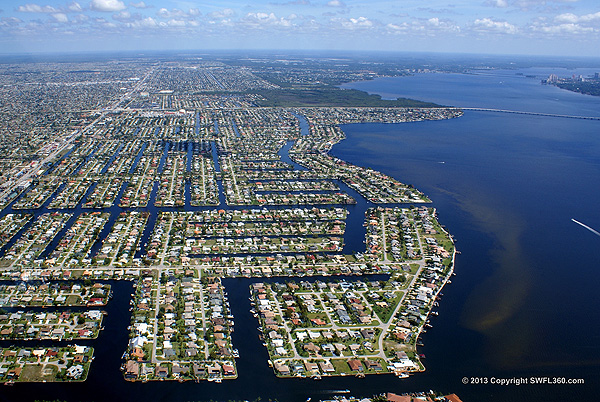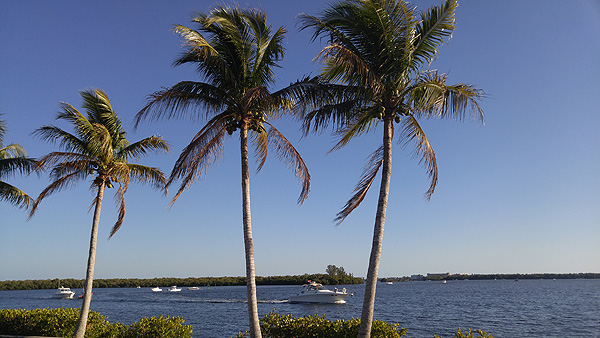Cape Coral, Florida
Cape Coral is a city located in Lee County, Florida, The city's population in 2020 is approximately 200,000. With an area of 120 square miles (310 km2), Cape Coral is the largest city between Tampa and Miami. It is a principal city in the Cape Coral - Fort Myers, Florida Metropolitan Statistical Area. The city is known as a "Waterfront Wonderland", with over 400 mi (640 km) of navigable waterways, Cape Coral has more miles of canals than any other city in the world.
History
Cape Coral was founded in 1957. Real estate developers Leonard and Jack Rosen purchased a 103-square-mile (270 km2) tract known as Redfish Point for $678,000 in that year and, in 1958, began development of the city as a master-planned, pre-planned community.
The Boomtown That Shouldn’t Exist
The Gulf American Corporation (GAC) was formed to develop the area. Canals were dug, streets paved, houses and businesses built. Cape Coral was promoted like no other Florida development. Celebrities were brought in to tout the benefits of "the Cape", as it is known locally. The first building was the Rosens' company headquarters, at the corner of Coronado and Cape Coral Parkway. Cape Coral's first permanent resident was Kenny Schwartz, the Rosens' general manager. Cape Coral's first four homes were completed in May 1958, on Riverside and Flamingo Drives.
Development continued through the early 1960s, mostly on Redfish Point, south of Cape Coral Parkway. By 1963, the population was 2,850; 1,300 buildings had been finished or were under construction; 80 mi (130 km) of road had been built, and 160 mi (260 km) of canals had been dug. The public yacht club, a golf course, medical clinic and shopping center were up and running. A major addition for Cape Coral was the construction of the 3,400 feet (1,000 m) long Cape Coral Bridge across the Caloosahatchee River, which opened in early 1964. Before the bridge, a trip to Fort Myers was more than 20 mi (32 km) via Del Prado Boulevard and over the Edison Bridge to cross the river.
There was a lot of hype, promotion and advertising. Celebrities like Bob Hope, Anita Bryant, and Hugh Downs were brought in. A movie with Phyllis Diller, The Fat Spy (1966), was filmed in Cape Coral and so were episodes of the TV show Route 66.

The city incorporated in August 1970, and its population continued to grow rapidly until the real estate slowdown that gripped the region beginning in 2008.
In its early years, Cape Coral was known as a community with many retired residents. This changed with a population and construction boom in the 1990s, which brought in younger families and professionals. Twenty percent of the population is seasonal residents. Nowadays, the city has a wide variety of businesses, retail shops and restaurants on its major arteries: Cape Coral Parkway, Del Prado Boulevard, Santa Barbara Boulevard and Pine Island Road.

Geography and climate
Cape Coral is located at 26°38'23"N 81°58'57"W.
According to the United States Census Bureau, the city has a total area of 120 square miles (310.8 km2). 110.09 square miles (285.1 km2) of it is land and 9.91 square miles (25.7 km2) of it (9%) is water. Cape Coral is a large peninsula and is bordered in the south and east by the Caloosahatchee River and in the west by Matlacha Pass. The city of Fort Myers lies across the Caloosahatchee River to the east, and Matlacha and Pine Island lie across Matlacha Pass to the west. Matlacha Pass is home to Matlacha Pass National Wildlife Refuge and the state's Matlacha Pass Aquatic Preserve.
Government
The City of Cape Coral operates under the council-manager government form of government. City Council members are elected at large from seven districts. The mayor is also elected at large and is the eighth member of the council. The mayor presides over council meetings. The City of Cape Coral provides police and fire services within the city.
City events
The city holds an annual Independence Day fireworks festival known as Red, White & BOOM!! This is the biggest single day event in the city and a large July 4 display for Southwest Florida. Red, White and BOOM is presented annually by the Chamber of Commerce of Cape Coral. Since 1985, the German-American Club holds an annual Oktoberfest, styled after the original held in Germany.The event draws on average 30,000 visitors. The Cape Coral Festival of the Arts is held the second weekend of January every year. The event takes place on Cape Coral Parkway and attracts over 100,000 visitors.Nearly 300 artists and craftspeople from across the nation line the street to make this one of the largest and best attended art festivals in Southwest Florida.
Since 1978 the Cape Coral Christmas Boat Light Parade has been held just before Christmas. The annual event features over 100 boats in all types of lighting decorations. The boats traverse the canals in the lower Cape starting at the Bimini Basin and 4 Freedoms Park. Since 2001 the annual Southwest Florida Burrowing Owl Festival is held in late February at the Rotary Park Environmental Center in Cape Coral. This event educates attendees of the unique wildlife found here such as the Florida Burrowing Owl, the Gopher Tortoise and the Florida Scrub Jay. The Burrowing Owl is the official city bird.
Cape Coral: A Booming Florida Beach Town With a Midwestern Feel
Cape Coral, the exclusive Southwest Florida master-planned community with a down-home Midwestern feel, is a popular destination for those who love life on the beach.
...
Weather in Cape Coral:
Also interesting: Moon Phases for Cape Coral, Florida, USA
See also the Weather.com forecast.
Infrastructure
Reverse osmosis water purification
In 1977 Cape Coral, Florida became the first municipality in the United States to use the RO process on a large scale with an initial operating capacity of 3 million gallons per day. By 1985, due to the rapid growth in population of Cape Coral, the city had the largest low pressure reverse osmosis plant in the world, capable of producing 15 MGD.
Roadways
Interstate 75 passes within 10 miles (16 km) of Cape Coral and connects northward to Tampa and on to the Midwestern states; and southeastward to Miami/Fort Lauderdale. Cape Coral borders on U.S. Highway 41. U.S. 41 and I-75 can be accessed from State Route 78 (Pine Island Road). Within the city a network of arterial roadways are established. Cape Coral has approximately 1,100 miles (1,800 km) of roadways. In general, the north/south routes are evenly spaced apart every one or two miles (3 km) and most of them have at least four lanes.
Bridges
Cape Coral is connected to Fort Myers by two bridges. The 3,400 feet (1,000 m) long Cape Coral Bridge connects Cape Coral Parkway to College Parkway in Fort Myers. The Midpoint Memorial Bridge connects Veterans Parkway to Colonial Boulevard. A number of other bridges span the Caloosahatchee River just east of Cape Coral in adjoining North Fort Myers.
Public transport
Public transit services in Cape Coral are provided by LeeTran. LeeTran operates 18 fixed-route bus services, including 6 within Cape Coral.[20] Buses operate Monday through Saturday between 5:00 am and 9:45 pm, depending on the route.
Airports
Cape Coral is 14 miles (23 km) from Southwest Florida International Airport (RSW), which serves nearly eight million passengers annually. The airport's new Midfield Terminal Complex opened in 2005, with three concourses and 28 gates. In 2010, eighteen national and two international airlines, as well as the two major cargo companies, served the airport.
In addition to Southwest Florida International Airport, Cape Coral is also served by Page Field, a general aviation airport in Fort Myers eight miles (13 km) from Cape Coral. Charlotte County Airport (PGD) is located in Punta Gorda, just 10 miles (16 km) north of Cape Coral.
Hospitals
Acute care and trauma is provided by Cape Coral Hospital. In December 2012, the Lee County VA Healthcare Center opened on Diplomat Parkway, providing a large range of medical services to veterans.
Utilities
The City of Cape Coral operates water and sewer systems for the city. Sewage is collected and highly treated to produce reclaimed water, locally known as "rescued water". Reclaimed water is distributed throughout the City through a dual water pipe system, and used for irrigation. Alternatively, reclaimed water can be discharged into the Caloosahatchee River.
The Cape was among the first in Florida to deploy the new 4.9 GHz pre-WiMax wireless channel authorized by the FCC in 2003 for exclusive Public Safety use.
Economy
The economy in Cape Coral is based on local government services, health care, retail, and real estate/construction. The City's Economic Development Office promotes and incentivizes business relocation to Cape Coral. In 2009 the City's top five employers were the Lee County School District, Cape Coral City Hall, Publix Supermarkets, Cape Coral Hospital and Walmart.

Education
Cape Coral has continuously expanding public and private school systems with high performance standards. Cape Coral is part of the Lee County School District, which is operated by the Lee County Board of Education. As of 2009, the Board of Education operated 8 elementary, 6 middle, and 5 high schools in the Cape.
There are four public high schools in Cape Coral: Cape Coral High School, built in the late 1970s, Mariner High School, which opened in 1987, and Ida S. Baker High School, founded in 2004 and named after one of the early principals of Cape Coral High School, with the building opening in 2005. The newest high school, Island Coast High School, opened its doors for the 2008-2009 school year.
In addition, the City of Cape Coral has created a municipal charter school system consisting of two elementary schools, one middle school, and one high school. The charter schools use the Core Knowledge and Cambridge Curricula. Since the system is public, there is no tuition. The municipal charter schools are available exclusively to children who live in Cape Coral.
The main campus of Florida SouthWestern State College is located immediately south of Cape Coral in Fort Myers. The college offers associate and bachelor's degrees, plus technical training in fields such as allied health programs, computer networking & programming, business administration, paralegal, criminal justice and fire science. 2009 enrollment was more than 16,000 students on four campuses.
One of Florida's youngest state universities, Florida Gulf Coast University (FGCU), opened in 1997 in nearby Fort Myers and now serves more than 12,000 students. FGCU has established a Cape Coral satellite facility, which provides Cape students with a growing offering of core courses. The university offers undergraduate, graduate, and doctoral degrees, including an executive master's program, a college of business and engineering and biotechnology programs.
Other colleges and universities serving the area are Hodges University, Southwest Florida College and Rasmussen College.
Cape Coral is also home to the Cape Coral Technical College, a postsecondary educational institution operated by the Lee County public school system. It provides training in medical, computer and food-science fields. Employer-specific training, both on and off-site, is available through Business and Industry Services of Lee County which maintains an office in Cape Coral.
Culture and recreation
The city features a sandy beach and fishing pier on the Caloosahatchee River at the public Yacht Basin & Club. Cape Coral is home to the expansive SunSplash Water Park (Virtual Tour of the Waterpark), more than 30 recreational parks, and seven golf courses. Cape Coral offers a variety of Gulf beaches in its immediate neighborhood, such as Sanibel Island and Fort Myers Beach. The area is known by birding enthusiasts for a wide variety of wildlife and the largest population of burrowing owls in the state of Florida.
Cape Coral's 400-mile (640 km) canal system provides many residents with waterfront living with access to the Gulf of Mexico via the broad Caloosahatchee River and Matlacha Pass. The Parks and Recreation Department maintains three public boat launching facilities. The Gulf of Mexico provides access to smaller tropical islands, rookeries, and sports fishing grounds.
Cape Coral's cultural assets include the Historical Museum, the Art Studio, the Cape Coral Art League, and the Cultural Park Theater, a 187-seat performing arts facility that serves as home to community actors. In addition, there are several regional arts and performance venues in the immediate area, including the Barbara B. Mann Performing Arts Hall.
Several parks and ecological preserves allow observation of the local wildlife. Elevated nature trails wind through the mangroves at Four Mile Cove Ecological Preserve.
Mike Greenwell founded an amusement park called "Mike Greenwell's Bat-A-Ball & Family Fun Park" that opened in February 1992.
Flora and fauna
The area supports waterfowl, wading birds, migrant songbirds, gopher tortoises, dolphins and reptiles. Rotary Park is home to wading birds, raptors, butterflies, foxes and other wildlife. Nature enthusiasts can track exotic birds and native fish from the boardwalk at Lake Kennedy and watch the West Indian manatees at Sirenia Vista Park. Cape Coral is home to the largest population of burrowing owls in Florida.









